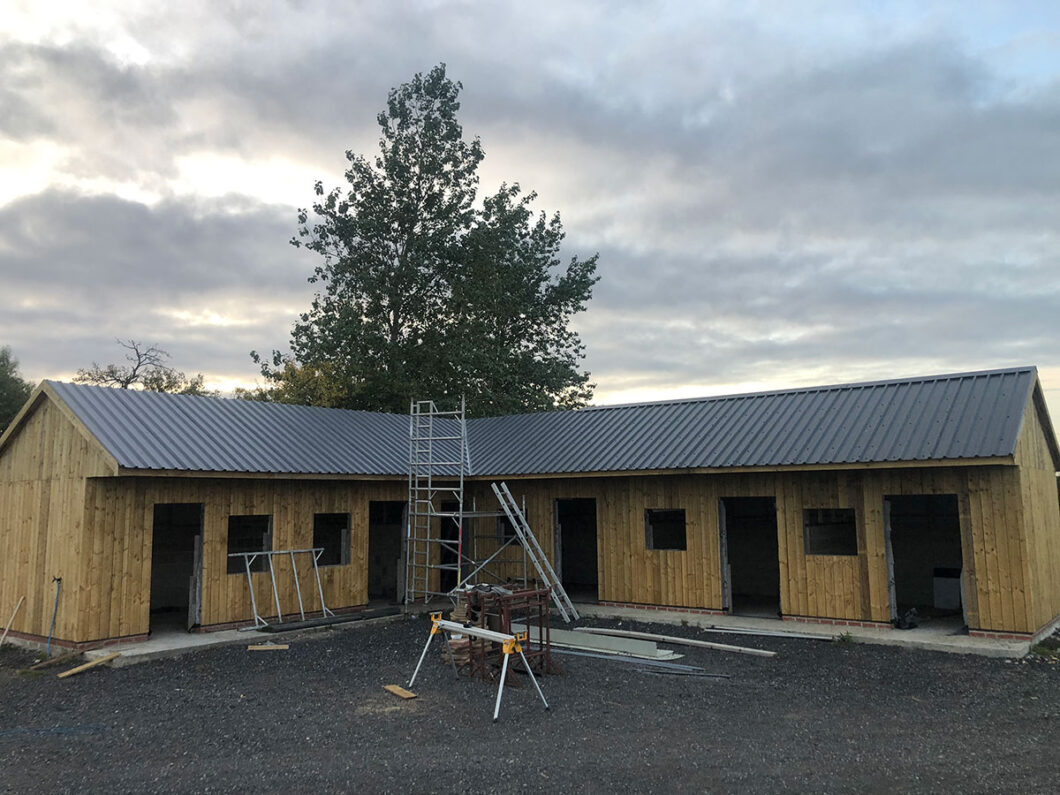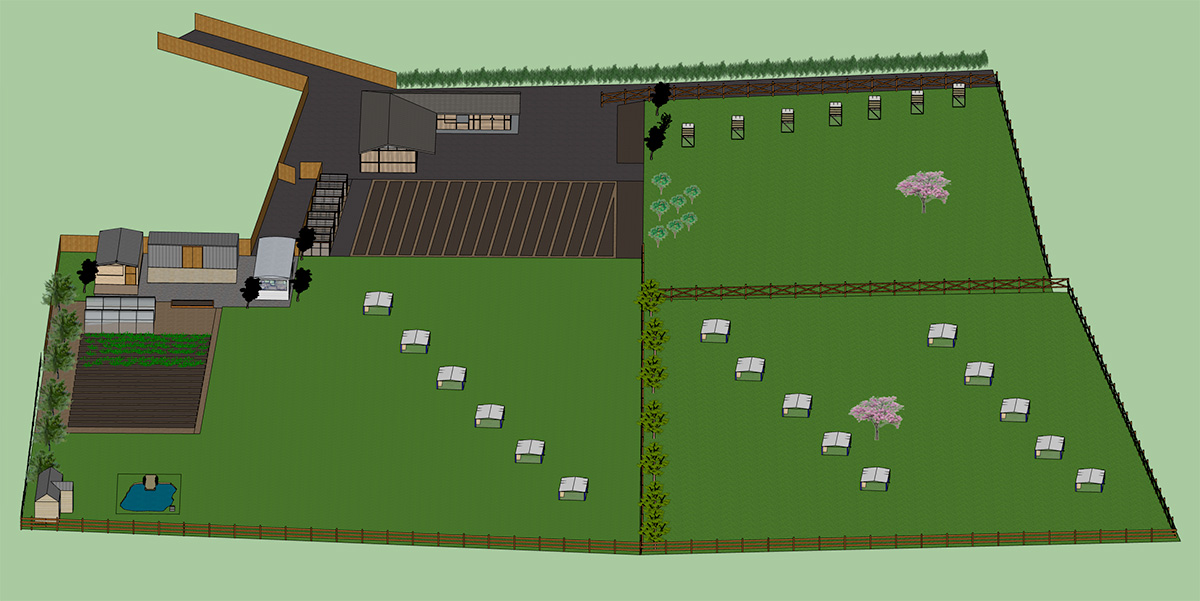Stables can cost anywhere from £800 for 1 Mobile Field Shelter – The Sky Is The Limit. It all depends on what size and type of stables you are looking for. But I can give you an idea of what a quality set of 6 stables costs to build.
If you are building the stables yourself you can lower the cost dramatically.
In this post, I will run through what it cost me to build the stables in the image above. We can also discuss how you can get the cost of materials cheaper.
I will give you a few tips on how to get the price down if you intend to build your own stables.
Most of the construction I did by myself, but I did hire a bricklayer to do the Block Work. That is a bit out of my skill set.
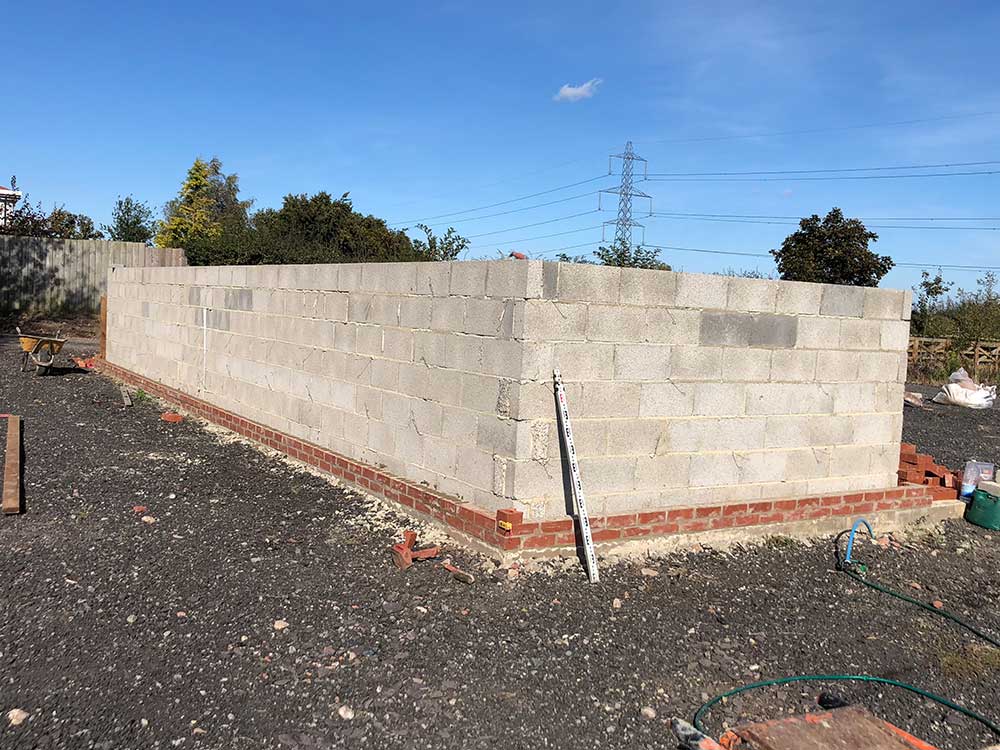
I will tell you what it cost me for each separate part of the construction..?
Now I do like to find the cheapest place to purchase my materials from. So if you are just going to purchase your materials from the first place you find them.
Then your stables could cost you around a third or more to construct. Hunting around for cheaper suppliers really pays off and you do not have to sacrifice quality either.
If you choose to hire a company to build a stable block, like the one I built. Then the cost of doing so will be significantly more. I am talking around £30,000 maybe more.
After all keeping horses is an expensive hobby. So stable construction companies charge you a lot of money to build stables.
I would like to mention one more thing. That I have never built stables before. So I was in the same boat you are now. But I am good with my hands and if you are too. Then there is no reason why you cannot build your own stables also.
So let’s dive into it what did each part of building my stables cost..?
Do You Need Planning Permission For Your Stable Block
Most stable blocks will need Planning Permission if you live here in the UK.
You can get away with using mobile field stables or shelters without the need for planning permission. But you may still need to inform the council of your intention to build them.
When it comes to how many stables you can build on one piece of land. This depends on the size of the land or paddock you want to build on. The standard is one stable for every acre of land you have.
They say one stable per acre is what is recommended per horse. But I have seen 8 stables on less than half an acre so the jury is still out on how many you are allowed…?
I guess it depends on where you are located. You may have grazing land close to where you want to locate and build your stable block.
Me I got planning for 5 stables and a tack room on 6 acres of land.
Building Your Stable Concrete Pad
First, if you are building a static stable block, you will need to build a reinforced concrete pad. If you are constructing a stable block with a timber frame as I did. You will want to have your stable block base around 100mm minimum thick.
First, you will need a sub-base of crushed rock or in my case I allowed local builders to tip free.
I only allowed them to tip-clean concrete or brick. Then I added some finer crushed stone to the top. All of this cost me around £500.
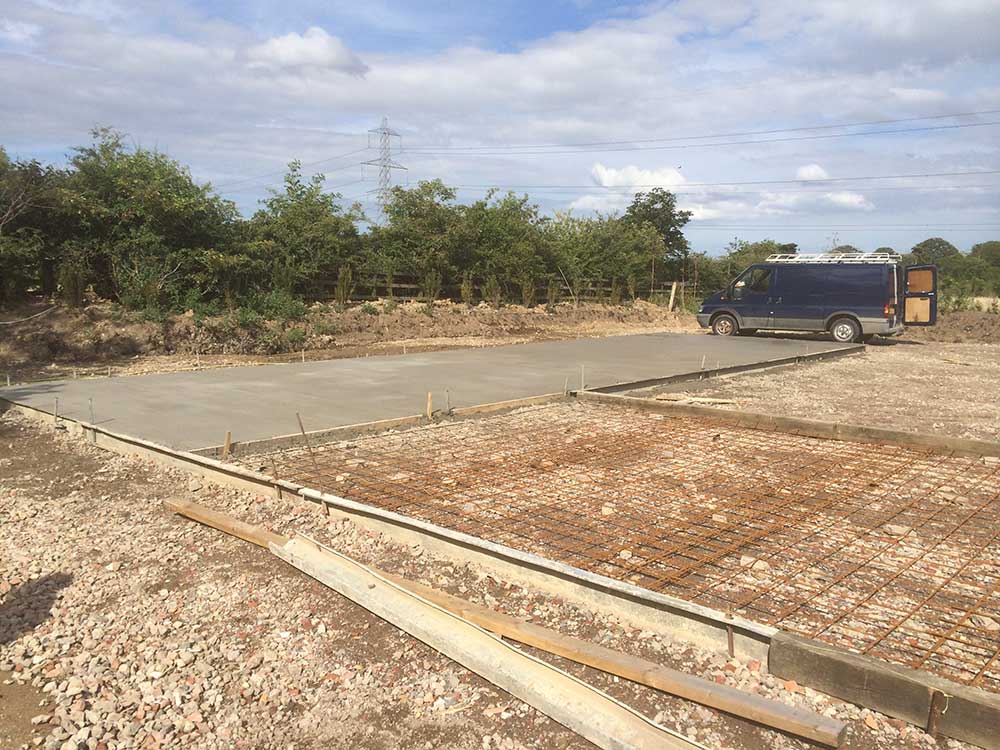
I also went for a 150mm thick concrete pad this is mainly because the concrete forms or shuttering was 150mm high. So I went with this thickness. Also in the future, If I wanted to build a heavier building on the slab I can.
But the minimum I would go for is 100mm thick. The cost of ready-mixed concrete is going to be the cheapest way to build it.
At the time I built mine. I paid around £120 per Cubic Meter for ready-mixed and delivered-to-site concrete. I think you get a discount when you purchase a decent amount.
If you can collect the ready-mixed concrete then you can get if for as low as £80 per Cubic Meter. But when you are on a large project this is not really feasible to do.
I needed a total of 17 Cubic Meters now considering 1 Cubic Meter weights around 2 tons. You would need a really big vehicle to collect more than 1 cubic meter at a time.
As for the steel reinforcing mesh, you need to cost around £33 per 3.6m x 2m mesh sheet. I managed to get mine for £20 per sheet from a leftover concreting job local to me.
The total cost of the concrete and reinforcing mesh came to £2300. But it may be a little more if you have to pay £33 for your mesh or cheaper if you can find leftover reinforcing mesh-like me.
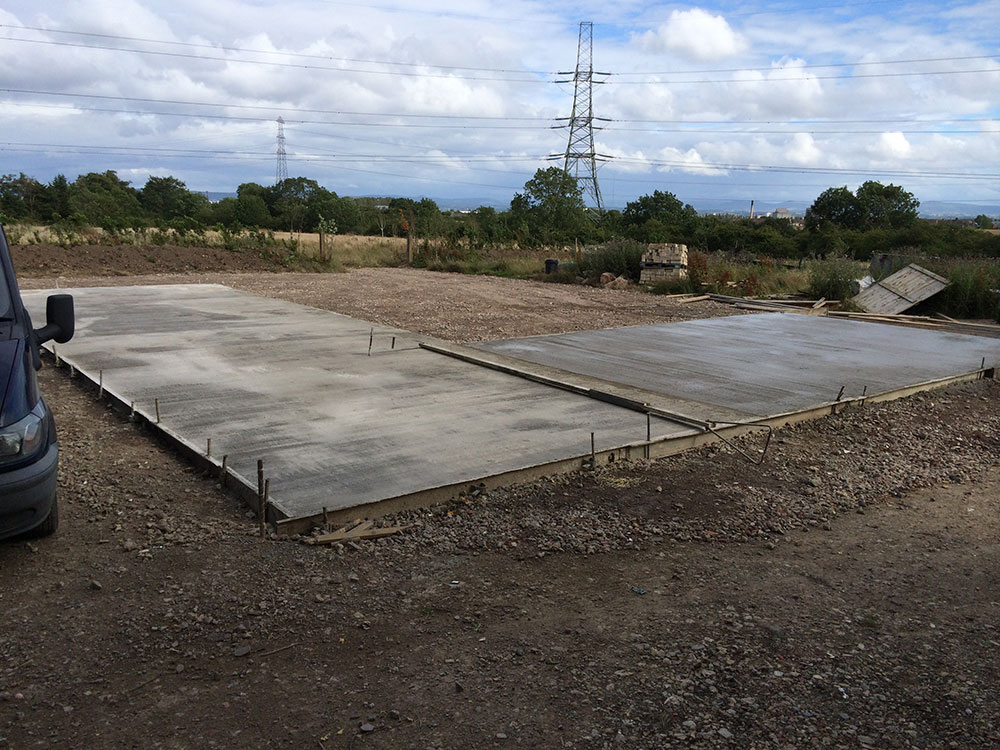
I would recommend looking in your local Free Ads Paper, Gumtree, Preloved even eBay etc. You may stumble across what you need…?
You can check out my article on How To Find Cheap Building Materials
Be very careful with concrete or you may learn the hard way as I did.
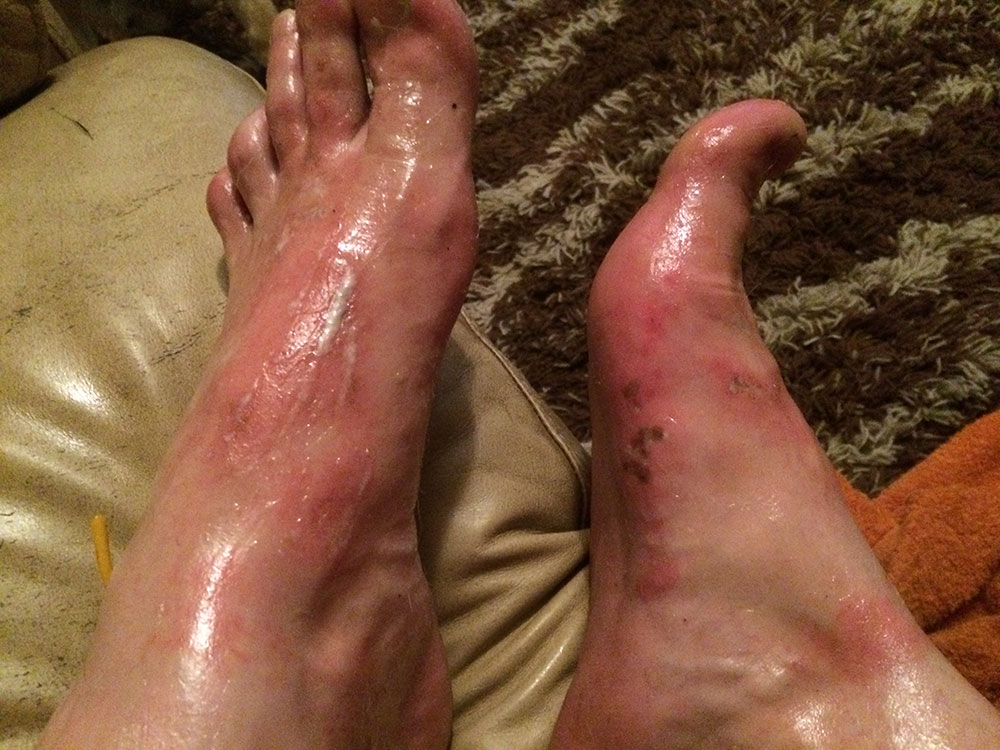
I had holes in my wellies and the concrete mix was getting in the holes. I did not feel any burning and did not notice until I removed my wellies. This is what my feet looked like after I had finished my concrete slab.
How to prevent and deal with concrete burns and neutralise them.
Trust me it was painful so you do not want to find out for yourself. Make sure you have wellies with no holes at all in them or you will be sorry.
Construction Of Stable Interior Block Work

After you have your stables concrete pad poured and cured you are ready to start your build.
I went with the design of a wooden framed stable exterior and concrete block internal walls. Now I have never done block work before so I hired a guy who did this part for me.
I paid £100 per day but I did know him. It took the guy 3 days to complete all the blockwork. All in all, I think it cost around £1500 for all the blocks, sand, cement and the guy to build the walls.
The engineering bricks for the wooden frame to sit on I laid myself. My back was killing me and it took me around 5 days. Lol, I wish I got the bricky to lay them honestly.
I got the engineering bricks from a leftover job and cost me £150. I think you can purchase a pack for around £200. In all I used 2 packs give or take a couple.
If you wanted to save money in this area. You can go with timber frame and wooden sheeting like Marine Ply Board or OSB Boarding. But I chose the concrete block walls for durability. As you know horses will chew their way through timber boarding.
Internal block walls will last forever and they are also better when cleaned. If you want to clean your stables out with a hosepipe. It’s easier if you have concrete blockwork than timber walls.
Building The Frame Work For A Stable Block
The framework I used for my stables was 4×2 rough-sawn timber. Now I could have used treated timber.
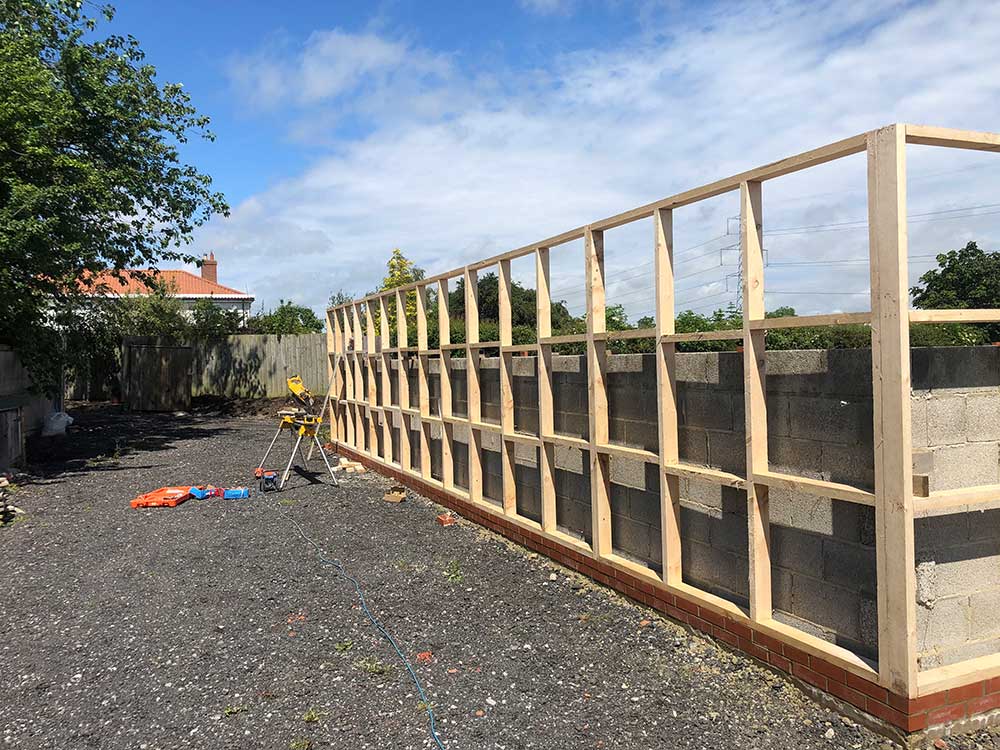
But I was using a different type of exterior boarding than the usual shiplap or log lap boarding. This meant I was using a wind and rain barrier between the frame and exterior board as you can see in the images.
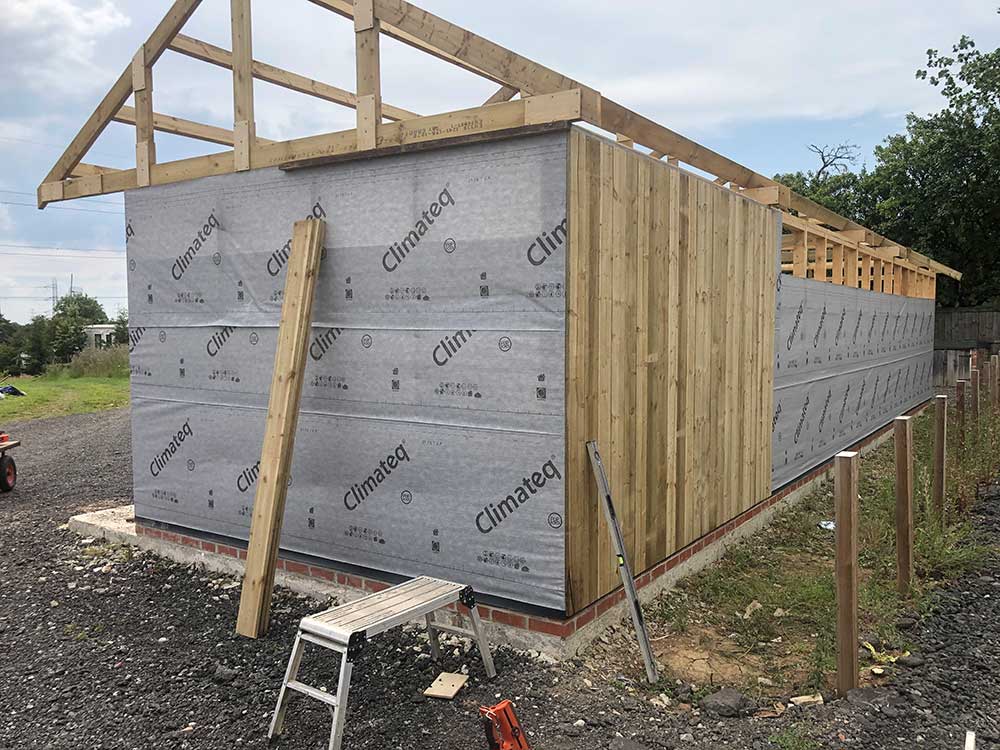
No water is ever going to come into contact with the framing so I used untreated. Will I live to regret it..? Maybe but I saved a couple of quid.
I should really have gone with treated timber. It would have only cost me an extra hundred or so.
What you don’t need is C16 or C24 construction-grade timber for your frame. It is not a house and treated rough-sawn timber will do you just fine.
In total the framing 4×2 untreated cost me £548 which for the whole frame not including the roof. I thought this was pretty good considering the size of the stables.
Building The Stable Roof
The framing for my stable roof. I did go with Pressure-Treated 6×2 C16 Construction Grade Timber. I made my own trusses and I used the first one I built as a template for the rest.
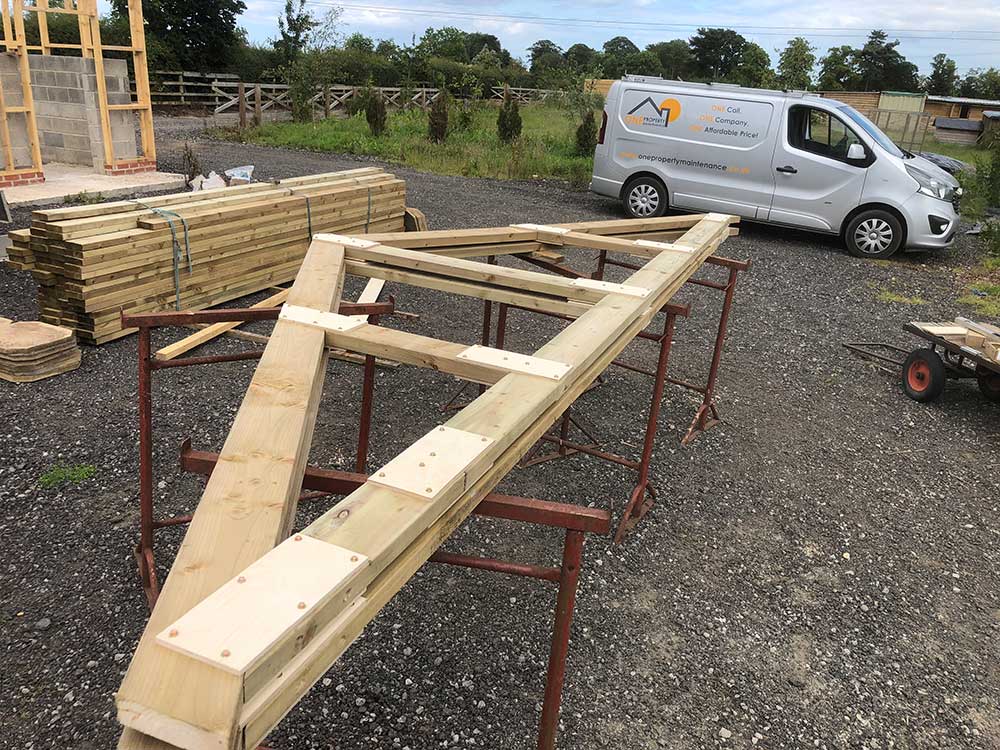
Also, when I designed my stables I used the design program Sketchup to do it. Pretty easy to use. It does take some getting used to if you are just going to use it for one building. I would get someone else to design your stables for you.
I use it all the time and have for many years so pretty simple. But What I did was keep the lengths of timber as close to what are standard lengths in the industry.
Standard lengths of timber in the timber industry are 1.8m, 2.4m, 3.0m, 3.6m, 4.2m, 4.8m and so on. So if you are building anything. A roof in my case I used 3m lengths when designing it.
This way I knew which lengths to purchase. I only needed to cut off a little of the 3m length. What I am trying to say is. If you don’t know what lengths of timber you need. Then you may purchase 4.2m lengths when you only needed 3m lengths and end up wasting 1.2m.
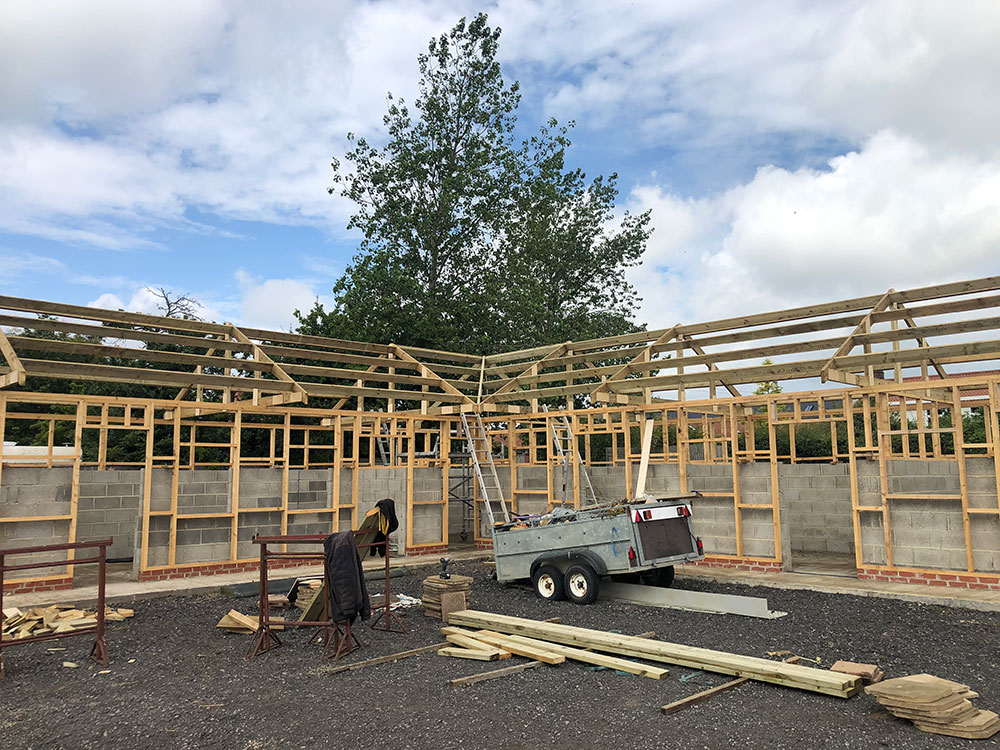
This is what my neighbour did and when I finished my stable framing you could get all the offcuts in a couple of sacks.
On the other hand, when he finished his stables he had a huge pile of 1m lengths etc left over. This is all wasted money.
Do your best and try to get your timber frame as close to the standard lengths as possible when designing your stables.
All in all, I managed to get my roof trusses and purlins for a total of £685.
The pieces of ply I used to join the timber on the trusses I got for £20. Again purchased as leftovers. But if you need to purchase this timber you would have to pay around £80.
Boarding To Use For The Stables
Now most stables are built using a tongue and groove timber like log lap or shiplap. I wanted to be different and after looking around I went with 150mm x 22mm ruff-sawn treated timber boards.

Instead of placing my board horizontally, I placed my board verticle. I got the timber merchants to cut a third of the boards into 3 pieces and retreat them.
This gave me 3 x 50mm wide boards from one 150mm board. I used these to cover the gaps between the first row of boards.
I think that getting the boards cut into thirds and covering the joints looks great
The main reason I did this was to look at what was available for the price I wanted. Also, the thickness was too thin at 15mm thickness. Or it was just too expensive.
In the end, I think it looks great and many people even my neighbours have complimented me on the look. The look of the stables is different than most and it is very strong also.
The cost of the boarding was £868 in total. To cover the whole stable exterior is a great price.
Roof Covering To Use For Stables
For my stable roof, I went for PolyCoat Anthracite Grey Box Sheeting. You could go for Plasticoat Box Sheeting which is around a third more expensive.
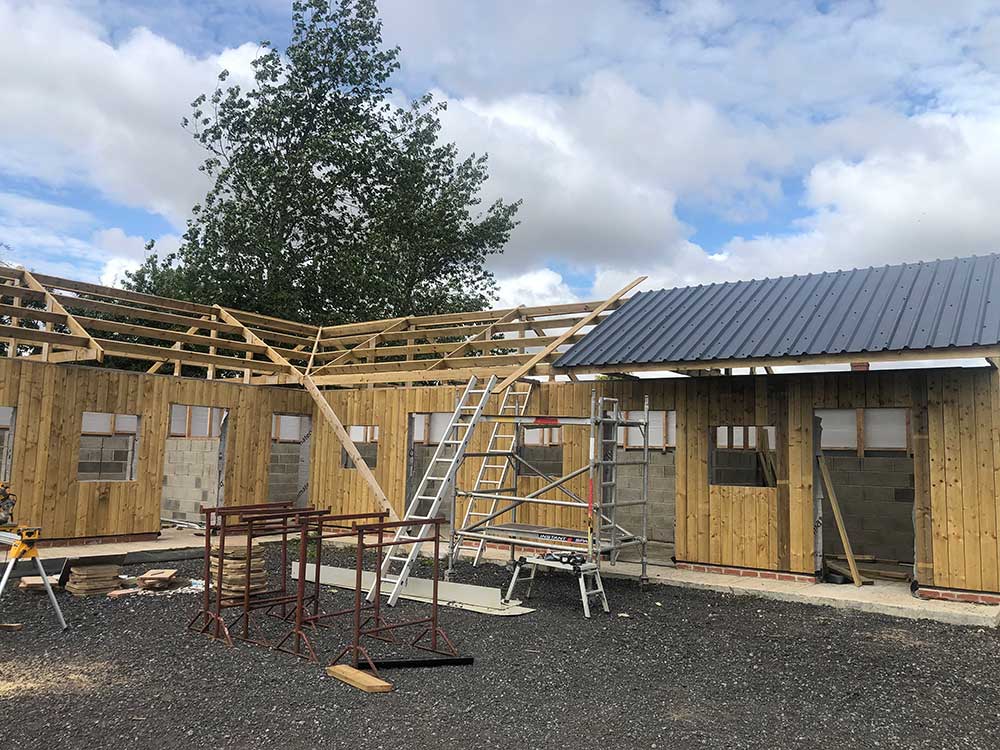
 Attaching the roofing sheets is pretty simple and the colour really compliments the timber
Attaching the roofing sheets is pretty simple and the colour really compliments the timberI purchased 50 x 3 meters in length x 0.5m thick sheets which cost me £10 per meter. The total cost was around £2000 for the whole roof covering including ridge and box ends, fixings etc.
Now it pays to shop around when it comes to roofing for your stables. I found that some suppliers wanted double what I eventually paid for my stable block roof.
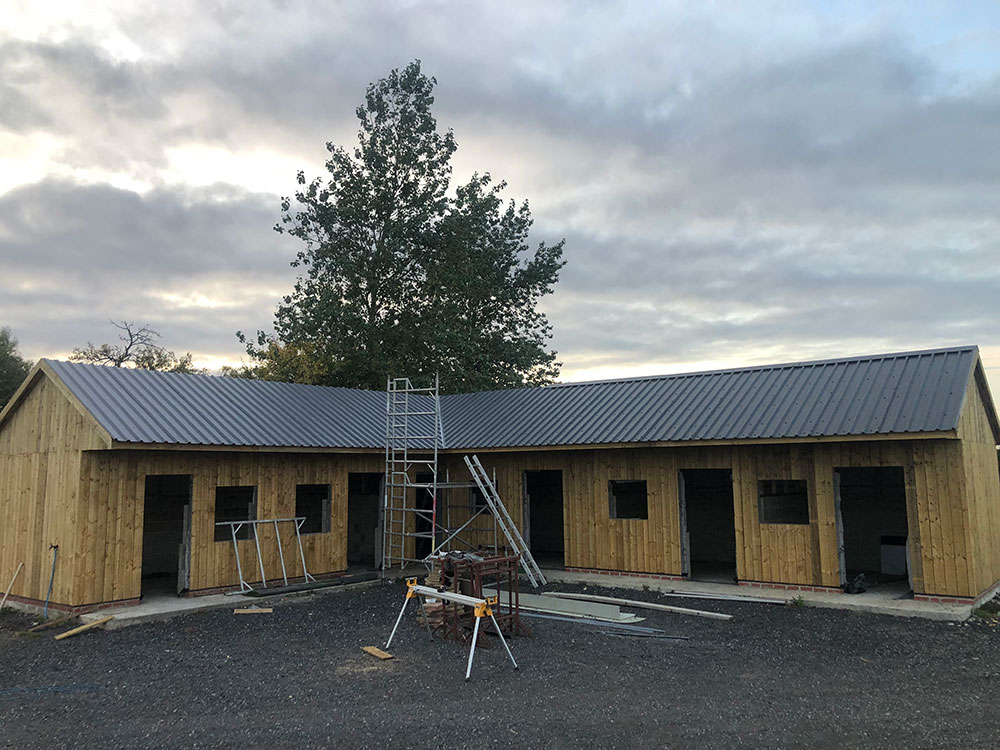
The cost of stable doors would be around £220 each if you purchased them ready-made. So in all, I would need 6 doors totalling £1380. I could build these doors and get that price down.
But the price of £220 also includes all the fixtures and fittings. If you include the time it takes to build a stable door. Also the fixings etc then it may be better to purchase ready-made doors
I will be using my stables for a different reason than keeping horses. So will not be going down the stable door route. But the stables still needed to be built to a high quality in case I ever want to sell them. I probably never will but just in case..?
These are my tips for finding cheaper materials. They are mostly common sense if you are wanting the best stables at the best price.
- Always look around when purchasing new materials. Even if that means you have to travel to collect them. I saved £1000 for my roof but I had to travel 80 miles and collect it.
- Try and find people you know with skills you may need as I did for my blockwork. You may need help with laying out your concrete slab. And friends with knowledge or skills may help you for free or charge less.
- If you are building your stables yourself and have time beforehand to collect the materials needed to build them. Then look at all the second-hand selling sites. Places to look would be Facebook Market Place, eBay, Gumtree, Craigs List, Preloved even Freecycle.
- Also when purchasing timber for a large stable block like mine. Remember to haggle for the best price possible. Get a quote from one timber merchant and then ask another if they can beat it..?
So What Was The Total Of My Stables
Let’s see what each part cost to build and the time it took to build them.
- Sub Base for my concrete pad £500
- Stable Block Base. Total cost for 17 cubic meters of concrete delivered to site – Plus Reinforced Mesh £2300
- Interior Block Walls – Plus 2 Course of Engineering Brick – Including Labor £1500
- Frame Work For Stable Walls £548
- Roof Framing £685
- Boarding For Exterior £868
- Roofing Sheets, Ridge, Box Ends & Fixings £2000
- 6 Stable Doors & All Accessories £1320
- Screws needed For Stables £60
- Bolts Used In Stables £120
- Nails For Paslode Nail Gun £150
Total Cost Of 6 Quality Built Stables – £10,551 Give or Take
Time to build a stable slab and to cure 3 days. Time to build 6 stables 16 working days.
I think you could do the work and build faster if you had more help or worked longer days than we did.
There were only 2 of us building these 6 stables and the Brick Layer took 3 days.
These stables are quality-built stables and will last a long time. Pitty I am not using mine for stables anymore. This is why you do not see the doors on them. But I did price the doors and that was the price I found and also the best.
If you were building just one stable to this standard. I would say you could do it for around £1500 and two stables would cost £3000. You get more discount the more materials you purchase. This brings the price down and for the standard and quality of materials used, I think that’s a good price.
Remember I like to shop around and haggle for my materials to get the best prices. I think you just went to the first place that sold what you needed. then you could add an extra £2000 – £3000 on top of what I paid.
Like they say it does pay to shop around. You will save money if you do.
What would the cost be for a company to build this sort of stable block.? Well, that depends on many factors where you live and what fit and finish you choose.
As I said earlier you could use a 100mm concrete slab. But you may choose 0.7mm thick roofing sheets with plasticote covering. these cost more than the ones I used.
But overall I think you are looking in the £25,000 – £30,000 range. So as you can see there are big savings to be had.
If you look around for the best pricing on materials and do the construction work yourself.

